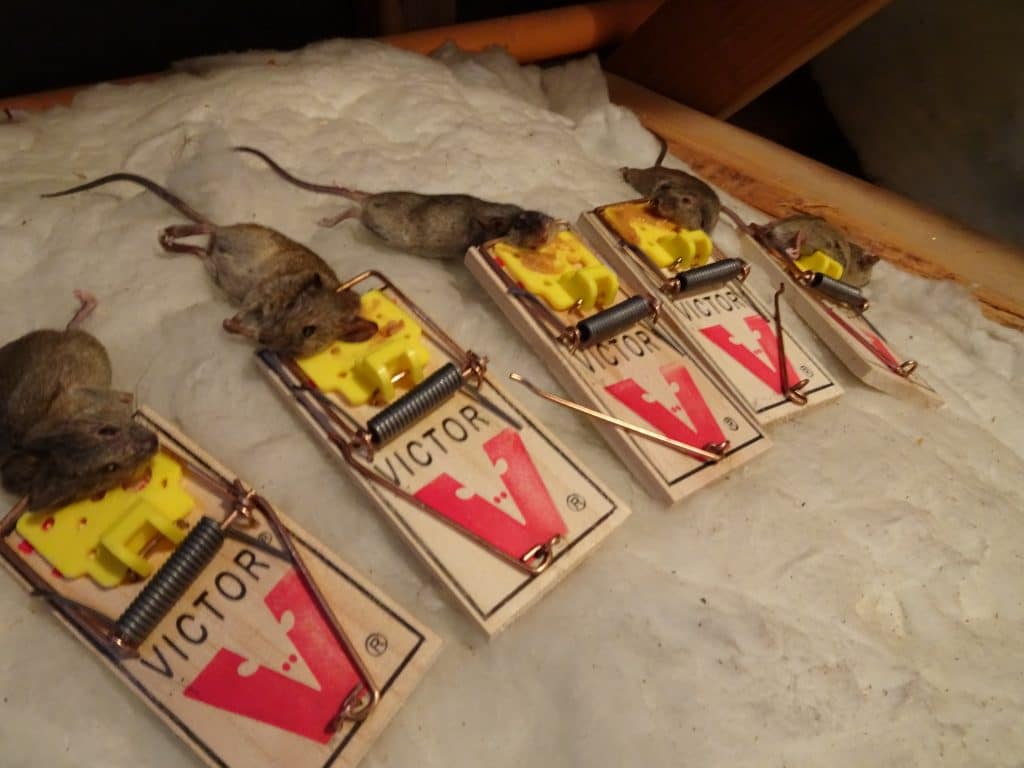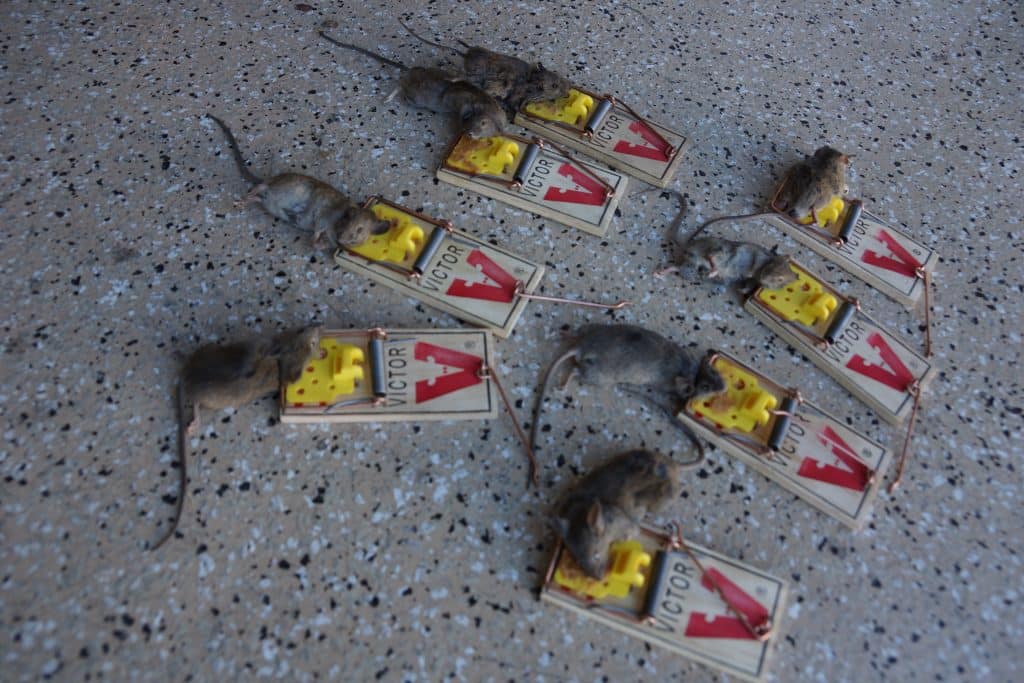Mice are small and flexible, so they can slip into your home through the tiniest cracks in search of food and shelter. Indications that a mouse has taken up residence in your home include gnaw marks, chewed food packaging, mouse droppings, and the distinctive smell.
Mice control begins with prevention; if you can keep them out of your home, you won’t need to extract them. If they have gotten in, there are several different means of handling mice problems: removing debris and food sources, sealing up their entry points, and trapping them.
EXCLUSION
To prevent mice nesting in your home or property, remove areas that act as a shelter, and any food sources.
- Clean up woodpiles, or store them at least 20 feet away from buildings.
- Trim shrubs and keep your grass short.
- Store food securely in airtight glass or tins.
- Clean up any food outside (spilled birdseed from feeders and left-over or unattended pet food).
- Inspect the house and shed for holes and cracks 1/4 inch in diameter or larger, and seal them using mesh or polyurethane foam.
REPELLENTS
Another way to try and get rid of your mouse problem is to use repellents. While not guaranteed to be an effective measure on their own, employing them in combination with other mouse control methods may be useful.
Here are some of the scents you should use:
- Peppermint oil
- Cayenne pepper
- Pepper
- Cloves
TRAPPING
The best way to deal with a mouse problem in your house is to trap them. The key to effective trapping is their placement and number. You will rarely have a lone mouse, so set several traps in areas they run through and near mouse holes. Once you set the traps, be sure to check them regularly.
There are different kinds of traps to choose from:
- The snap trap‘s design is intended to break the rodent’s neck or back upon impact, killing it instantly. However, sometimes the trap only severely wounds the animal, and it’s up to you to kill the mouse humanely before disposing of the dead body.
- Live traps catch the mouse in a cage, allowing for relocation.
- Glue traps trap a mouse but don’t kill it. If not found quickly and killed humanely, it’s left to die of starvation and dehydration. This is one of the most inhumane means of dealing with rodents.
The best bait for trapping mice is peanut butter, but bacon, salami, oatmeal, dried fruit, and chocolate also work.
POISON
Rodenticides are another means of pest control; however, because they don’t kill the animal instantly, they create further problems:
- Mice may crawl into hard-to-reach places before dying, leaving you with the smell of a dead and decaying animal in your walls or roof space.
- Mice have many natural predators; any that eat a poisoned mouse will ingest second-hand poison and suffer the same effects.
When in doubt about the best way to proceed, give us a call, and we will take care of the problem for you.

Damages That Mice Do To Your Home
Mice need no introduction. Though they are quite small (adults weighing about 30 g), their destructive capabilities are out of this world. With their sharp teeth, they chew on all sorts of materials within the home. What’s more, they contaminate food sources and pollute your house with their droppings.
Our professionals at Precise Exterminating Service Inc are experts on mice control. And if there’s one thing you should know, it’s that mice infestation should be handled promptly. If you fail to heed this warning, it’s only a matter of time before they wreak hundreds or thousands of dollars in damages.
So, what exactly are these damages caused by mice in homes?
- Structural Damages
The incisors of mice grow throughout their lives. To keep this growth in check, they incessantly chew on whatever they can lay their teeth on. In the attic or home, mice are known for chewing wood, pipes, wires, and many other substances.
If the mice damage load-bearing beams in your attic, they weaken the overall structural integrity of your building.
- Fire Hazards
About 25% of house fires are attributed to “unknown causes”. If a large chunk of this number is caused by mice, we wouldn’t be surprised. You see, mice are notorious for gnawing on electrical wires.
This can result in partial contact that can cause electrical sparks, which may start a fire. What’s more, partial contact can also damage household appliances.
- Health hazards
Mice are known for their filth. So, it’s no surprise that they’re carriers of a wide array of diseases. Common examples include Hantavirus, tularemia, and leptospirosis, among many others. These diseases are commonly transmitted through their bite, scratch, saliva, urine, and feces. That’s why you must always avoid direct contact with these nuisance pests.
- Food contamination
Once mice get into your house, they begin to search for food sources. They’ll eat food crumbs on the floor and lick away leftovers from unwashed dishes. But that’s not all. They will also look for foodstuffs like sugar or a box of cereal and take their share from it.
As noted in the last point, the saliva of mice can transmit several diseases. Hence, food contamination is a serious problem caused by mice.
- Damaged insulation
In the attic, mice rely on tearing off the insulation to build their nest. By doing so, they reduce the heating efficiency of your home, and this translates to higher energy bills.
- Noise pollution
There’s nothing more frustrating than lying down to sleep at night only to hear the chitters of mice coming from the dark. Or even worse, hearing scurrying feet of mice zoom past you. For many homeowners, this is an undesirable experience.
- Leaving waste products
The urine and feces left behind by mice create lots of mess. First off, the appalling smell of their waste can pollute the air in your home. What’s more, these waste products are a breeding ground for bacteria and several other diseases.
- Damaging household objects
Mice will chew on just about anything within the house – including paper, cloth, and books. They will also gnaw and burrow into upholstered furniture, and seats of cars to create a hidden nest.
What To Do
To prevent mice infestation, you need to make your house unattractive to these nuisance rodents. This means eliminating all potential food sources, as well as hiding spots. What’s more, you need to seal up all entry points to deny them entrance.
Dealing with nasty mice in your home? Promptly contact us today at Precise Exterminating Service Inc for professional rodent control.

How To Remove Mice In The Attic
Mice and rats are common enough for house guests largely because of their immense resourcefulness. These rodents are willing to jump through a lot of hoops to secure food, water, and safety for themselves, and often enough, they hit some sort of jackpot with human homes that encapsulate all three.
Most often, mice can be found up in the attic of your home, because it’s crowded, but also a largely lonely space. Because of this, they get plenty of space to hide behind the boxes, and things you usually store up there, but also run fewer risks of being discovered.
So what can you do about mice in the attic?
First of all, let’s understand why you want to do something about the mice in the first place. Aside from the obvious terror that some people nurture over mice and rodents in general, mice on your property can cause quite a bit of damage to your home. They’re quite likely to chew through wooden structures, insulation, and electrical wires, and thus pose very serious threats to the safety of you and your loved ones.
Not only that, but rodents are also big carriers of a host of diseases that can range from mildly unpleasant to fatal. So it stands to reason you’d want to get rid of them asap.
Contact a professional.
If you don’t know what to do about the rodents in your attic, or just don’t want to have to deal with all the mess and the trouble involved in DIY mouse trapping, you can just call a professional wildlife removal company. Not only will they be able to rid you of a problem swiftly and efficiently, they will also most likely offer attic restoration and sanitization services, and be able to advise you on future prevention tips.
Try live trapping.
Live trapping is another great way to stymie the mouse invasion in your attic, while also retaining a level of humanity since living traps are designed in such a way so as not to actually hurt the mice. Once lured inside the cage, the door will shut, and the mouse will be left to await relocation.
If you’re looking to get rid of the mice yourself, but are put off by lethal choices like snap traps or poisoning, live trapping might be the best option for you.
Of course, those traditional mouse trapping and poisoning options are also available to you, if you like. Unfortunately, these are about the only options you’ve got if you’re looking for attic mouse removal.
While other options are available, like deterrents or repellents, those are more preventive measures, rather than actual removal options. Speaking of which…
How can you prevent mice from bothering you again?
The first thing you need to do, once you’ve removed the offending rodents, seals the holes in the walls or roof that the mouse came through. Remember that the longer you leave these unattended, the likelier it is you’ll attract other rodents or even larger or more dangerous animals. You’ll want to seal the entry points using wire mesh, expanding foam, or concrete, so as to prevent animals from chewing or gnawing their way into your home.
If you’ve struggled with mice in the past, it may also be a sign you need to step up your cleaning and storage game. Since mice are attracted to food-rich properties, you may need to clean up more frequently and start storing your foods in airtight, sealed containers.
If you like, you can also use sound or light deterrents to scare off mice in the future.
